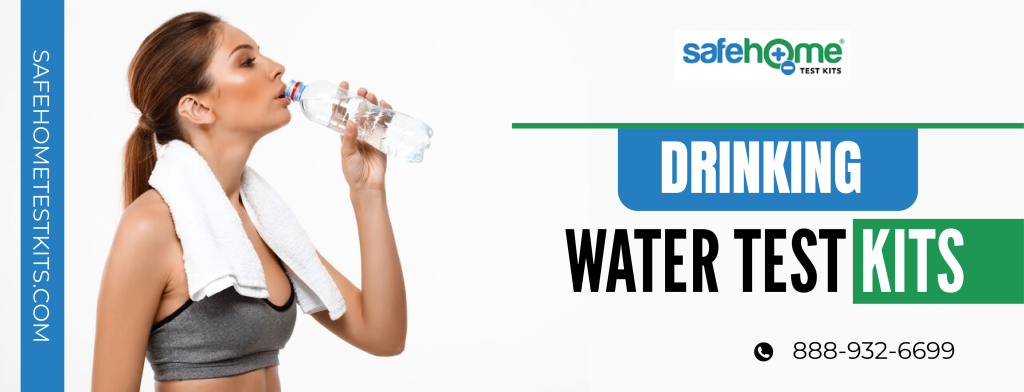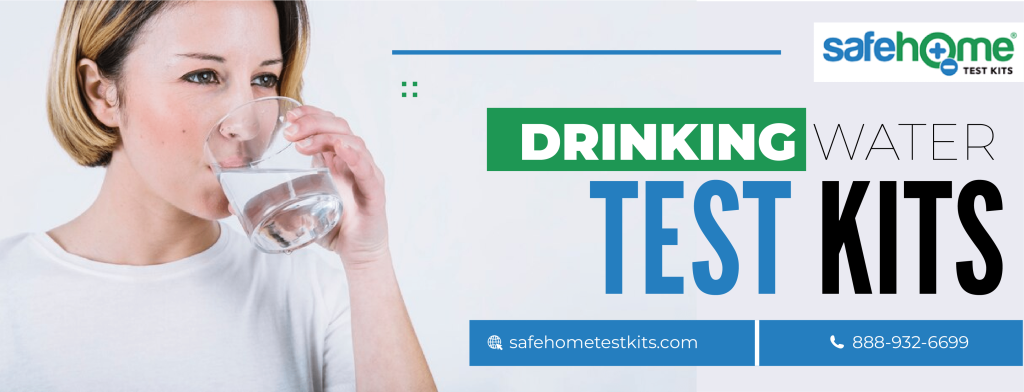Understanding Water Contamination: How Safe Home® Test Kits Can Help
Water, the elixir of life, is essential for sustaining all life forms on Earth. However, the increasing threat of contaminants is not just a concern, it’s a crisis. Water contamination is posing significant risks to human health and the environment, and it’s time we take action. In this blog, we delve into the complexities of this crisis, exploring its causes, effects, and potential solutions.
Understanding Water Contamination
What is Water Contamination?
Water contamination occurs when harmful substances infiltrate water bodies, rendering them unsuitable for their intended purposes. This pervasive issue threatens human health, ecosystems, and economies worldwide.

Chemical Contaminants:
Chemical pollutants, including pesticides, heavy metals, pharmaceuticals, and industrial chemicals, leach into water sources through various pathways. Pesticides from agricultural runoff, heavy metals from industrial discharges, pharmaceutical residues from wastewater treatment plants, and industrial chemicals from manufacturing processes contribute to water contamination. These substances can accumulate in water bodies, posing risks to aquatic life and human health through direct exposure or consuming contaminated water and seafood.
Biological Contaminants:
Biological pollutants, such as bacteria, viruses, and parasites, contaminate water through fecal contamination, sewage leaks, or inadequate sanitation practices. Pathogenic bacteria like E. coli and Salmonella, viruses such as norovirus and hepatitis A, and parasites like Giardia and Cryptosporidium can cause waterborne diseases, leading to gastrointestinal illnesses and other health complications, particularly in vulnerable populations.
Physical Contaminants:
Physical pollutants, including sediment, soil runoff, and debris, degrade water quality and disrupt aquatic ecosystems. Soil erosion from agricultural activities and construction sites, runoff from urban areas, and littering contribute to sedimentation, nutrient pollution, and habitat degradation in water bodies. Debris pollution poses risks to aquatic life through ingestion and entanglement, further exacerbating the impacts of water contamination.
Causes of Water Contamination
Industrial Activities:
Industries discharge many pollutants into water bodies as byproducts of their manufacturing processes. Chemicals, heavy metals, and toxic substances are often released into rivers, lakes, and oceans, contaminating these vital resources. Effluents from factories and industrial facilities carry mercury, lead, arsenic, and various organic compounds, which can accumulate in aquatic environments and bioaccumulate through the food chain, posing threats to marine organisms and human consumers. Industrial discharges continue exacerbating global water contamination issues without proper treatment and regulation.
Agricultural Runoff:
Modern agricultural practices heavily rely on pesticides, fertilizers, and animal husbandry, leading to significant contamination of water sources. Rainfall washes agricultural chemicals from fields into nearby water bodies, contaminating groundwater and surface water supplies. Pesticides, herbicides, and fungicides applied to crops can leach into soil and runoff into streams and rivers, posing risks to aquatic life and human health. Moreover, waste from concentrated animal feeding operations (CAFOs) can introduce pathogens and nutrients into waterways, contributing to eutrophication, algal blooms, and waterborne diseases.
Urbanization:
Rapid urban development alters natural landscapes, increasing impervious surfaces and altering hydrological processes. Urban runoff carries pollutants such as heavy metals, oil and grease, sediments, and litter into stormwater drains, ultimately discharging into water bodies. The expansion of urban areas encroaches upon natural habitats, leading to habitat loss, fragmentation, and degradation, further exacerbating water contamination issues.
Improper Waste Disposal:
Improper disposal of various forms of waste, including sewage, household chemicals, and electronic waste, poses significant risks to water quality. Untreated sewage discharged into rivers and coastal waters introduces pathogens and nutrients, leading to bacterial contamination and eutrophication. Household chemicals such as cleaners, solvents, and paints can leach into groundwater, contaminating water sources and ecosystems. Improper electronic waste disposal releases heavy metals and toxic substances, further contributing to water pollution and environmental degradation.
Effects of Water Contamination
Water contamination has far-reaching impacts on human health, ecosystems, and economies, highlighting the urgent need for proactive measures to mitigate its effects.
Health Impacts:
Contaminated water poses significant risks to public health, leading to various ailments and diseases. Consumption of water contaminated with pathogens, chemicals, or heavy metals can result in gastrointestinal illnesses, such as diarrhea, vomiting, and stomach cramps. Long-term exposure to contaminated water may lead to more severe health issues, including reproductive problems, neurological disorders, and even certain types of cancer. The health impacts of water contamination are not to be taken lightly, particularly for vulnerable populations, such as children, pregnant women, and immunocompromised individuals. This underscores the importance of ensuring access to safe and clean drinking water for all.

Environmental Degradation:
Water contamination wreaks havoc on aquatic ecosystems, disrupting delicate ecological balances and leading to biodiversity loss and habitat destruction. Pollutants in water bodies can impair the growth and survival of marine organisms, including fish, amphibians, and invertebrates. Toxic chemicals, such as pesticides and heavy metals, accumulate in sediments and bioaccumulate in aquatic food chains, posing risks to wildlife and human consumers. Eutrophication, caused by excessive nutrient runoff, fuels algal blooms and oxygen depletion in water bodies, further exacerbating environmental degradation and compromising ecosystem resilience.
Economic Consequences:
The economic toll of water contamination is not to be underestimated. It encompasses costs associated with healthcare, environmental remediation, and lost productivity in affected communities. Treating waterborne illnesses and managing their associated healthcare expenses significantly burdens healthcare systems and households. Ecological cleanup efforts, such as remediation of contaminated sites and restoration of degraded ecosystems, require substantial financial investments and resources. Additionally, water contamination can impair local economies reliant on tourism, fishing, agriculture, and recreation, leading to income loss, job displacement, and reduced property values in affected areas. These severe economic consequences underscore the urgency of addressing water contamination.
Solutions to Water Contamination
Regulatory Measures:
Enforcing stringent regulations is not just a dream; it’s a reality we can achieve. Governments must implement and uphold laws that limit pollutant discharge from industrial, agricultural, and urban activities. By holding industries accountable for their environmental impact and imposing penalties for non-compliance, regulatory measures deter harmful practices and encourage the adoption of cleaner production methods. Together, we can make a difference.
Investment in Infrastructure:
Investing in water treatment facilities and infrastructure upgrades is critical for ensuring access to safe drinking water. By modernizing aging infrastructure and expanding treatment capacity, communities can improve water quality and reduce the risk of contamination. Investing in decentralized treatment systems and alternative water sources enhances resilience to contamination events and strengthens water security for vulnerable populations.
Public Awareness and Education:
Educating the public about water conservation and proper waste disposal practices is not just a suggestion; it’s a call to action. Each one of us has a role to play in preventing contamination. Public awareness campaigns and educational programs are crucial in raising awareness about the importance of preserving water resources and the consequences of pollution. Providing access to Safe Home® Test Kits and DIY Water Test Kits empowers individuals to monitor their drinking water quality and proactively address contamination issues.

Technological Innovations:
Developing innovative water treatment and pollution monitoring technologies is essential for addressing emerging contaminants. Advanced treatment methods, such as membrane filtration and ultraviolet disinfection, can effectively remove many pollutants from water sources. Furthermore, developing sensor technologies and remote monitoring systems enable real-time detection of contamination events, facilitating rapid response and mitigation efforts.
Conclusion
Water contamination significantly threatens public health, ecosystems, and economies worldwide. Addressing this complex issue requires concerted efforts from governments, industries, communities, and individuals. By understanding the causes and effects of water contamination and implementing practical solutions, our Safe Drinking Water Test Kits can safeguard this precious resource for future generations.
Explore our Home Water Test Kits here: https://safehometestkits.com/shop-drinking-water-test-kits/
Need to know how our kits work before purchasing? Please give us a call at 888-932-6699 or drop an e-mail at info@safehometestkits.com


